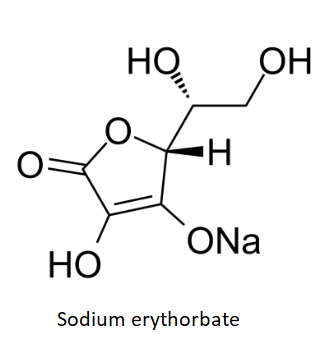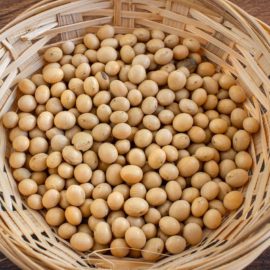
Sodium erythorbate is the sodium salt of erythorbic acid, an antioxidant chemically related to vitamin C. It is produced from sugars of various sources, such as corn, beets, and sugar cane. It is a common food additive in processed meat products, sodas, and sometimes in salads and baked products. Its E number (codes for food additives used within the European Union) is E316. Sodium erythorbate other names include Sodium isoascorbate and Sodium D-isoascorbic acid.
Sodium erythorbate is odorless, and appears as a white crystalline powder or granule. Its pH (acidity) is between 5.0 and 6.0. A 10% solution of commercial grade sodium erythorbate may have a pH 7.2 to 7.9. It is freely soluble at 16 g/100 ml of water. Sodium erythorbate is non-reactive in dry state. But it is an effective antioxidant when mixed with water as it reacts readily with oxygen and other oxidizing agents.
Sodium erythorbate is heat stable as it decomposes only at temperatures between 327.2°F (164°C) and 341.6°F (172°C).

In the food industry, it works as an antioxidant, preservative, and curing agent (color retention and reducing compound).
Let’s discuss further the food applications, production method, and safety of sodium erythorbate.
PRODUCTION METHOD
No! Sodium erythorbate is not made from earthworms. It is definitely just a myth. Sodium erythorbate is produced from fermentation of sugars. The microbes involved in the process is Pseudomonas fluorescens or Arthrobacter globiformis. The fermentation is performed at 86°F (30°C) to 95°F (35°C) for 30 hours. Sulfate and activated carbon are added to the fermentation broth as supplements for acidification and decolorization, and then the filtrate is pressed to achieve the clean liquid.
This broth is concentrated by compression. Sulfuric acid and methanol are added to the broth and then esterified for 5 hours. Freezing and centrifuged filtering obtains a yield of around 82% methyl ester, which is transformed using basic methanol solution. This is frozen and crystallized to produce the crude product of D-isoascorbic acid.
APPLICATIONS IN FOOD
Keeping fruits and vegetables fresh
Like vitamin C, sodium erythorbate has antioxidant properties. This means it can keep foods, fruits and vegetables, in particular, fresh for longer by inhibiting oxidation or enzymatic browning. Enzymatic browning is generally undesirable in foods. One good example of this is browning of a cut apple due to exposure to oxygen. The browning is caused by the interaction between the enzyme in the fruit called polyphenol oxidase (PPO), polyphenols or phenolic compounds, oxygen. This reaction forms quinones, the pre-cursors to brown pigments. Although it is safe to eat, it does not look appetizing, right?
You might also like: The Reason Why Sliced Apples Turn Brown
By spraying or dipping the fruit in aqueous solution of sodium erythorbate, the fruit stays fresh and browning is prevented. Sodium erythorbate does this by gathering oxygen and reducing the quinones back to polyphenol compounds, before they can undergo reactions that leads to browning.
Sodium erythorbate can also be used as an antioxidant in picking brine up to 7.5 ounces per 100 gallons.
Accelerating the process of curing
The process of curing meat and poultry involves the use of salt alone, or in combination of other curing ingredients like sodium nitrite, sugar, and spices. Sodium nitrate and nitrite contribute to the development of the distinct color and flavor of cured meats such as ham, bacon, and frankfurters. The interaction of the myoglobin heme with nitric oxide to generate the nitrosylmyoglobin pigment gives cooked, cured meats their distinctive pinkish red hue. Nitrite also prevents the growth of spoilage and pathogenic microbes, including Clostridium botulinum.
One known disadvantage of curing is that it requires time. By using sodium erythorbate, the curing time is shortened by increasing the rate of reduction of nitrite to nitric oxide.
You might also like: Myoglobin: The Protein That Dictates Meat Color
Nitric oxide is derived from nitrite in the presence of reducing compounds such as sodium erythorbate (erythorbic acid). Nitrite dissolved in water can form nitrous acid. In a reducing environment, nitric acid decomposes to nitric oxide. When this binds to the heme iron, the electron distribution in the heme structure changes, producing a pinkish color.
Reducing compounds, mainly sodium ascorbate and sodium erythorbate, are added in meat curing mixtures to reduce the time it takes to convert nitrite to nitric oxide and ferric ion of the heme to ferrous ion.
Since sodium erythorbate is also an antioxidant, it delays the onset of oxidative rancidity.
Preventing carcinogenic compounds in meat
The biggest concern in processed meat products is the presence of potential carcinogens. Processed meats contain nitrite to prevent the development of botulinum toxin, which causes botulism, a potentially fatal disease. Nitrite also helps develops the distinct pink color and flavor of cured meat, and prevents off-odor and off-flavor during storage.
However, nitrites could combine with amines. Amines develop as a result of protein breakdown in the stomach. This forms nitrosamines, one of the most carcinogenic compounds found in foods. In fact, it has been a great concern that multiple regulatory changes have been imposed to control the use of nitrite in meat products.
You might also like: Food Preservative: What Is Sorbic Acid (E200)?
One way to prevent nitrosamine formation is by using antioxidants such as erythorbic acid and its salt sodium erythorbate or ascorbic acid (vitamin C). These additives are effective in curtailing this undesirable reaction. Sodium erythorbate does this by interacting with nitrous acid, converting nitrite to nitric oxide. And since it raises the concentration of nitric oxide during curing, the formation of the curing pigment is much faster. It also maintains the bright pink color in processed meats. This is why many processors use sodium erythorbate in their products.
HEALTH CONCERNS
Sodium erythorbate is generally a safe ingredient in food. The governing agencies that have approved the use of sodium erythorbate in food include:
- U.S. Food and Drug Administration (FDA)
- Joint FAO/WHO Expert Committee on Food Additives (JECFA)
- European Food Safety Authority (EFSA)
The acceptable daily intake (ADI) of sodium erythorbate is at 6 mg/kg bw/day. The EFSA re-evaluated this in 2016. Based on studies that included its genotoxicity and carcinogenicity, the panel found no reason to revise the current ADI and that its permitted or reported use and use levels would not be of concern.
Although there have been some reports of people sensitive to the food additive. Side effects that may be experienced include dizziness, fatigue, and headache. Excessive consumption of sodium erythorbate may also contribute to the risk of kidney stones.
To prevent excessive amounts of sodium erythorbate in food, maximum permitted levels is in place. The below table shows the approved maximum limits of sodium erythorbate (also applies to erythorbic acid). (For other additives, you may refer here).
| FOOD | MAXIMUM PERMITTED LEVEL (mg/l or mg/kg) |
| Frozen/deep frozen/preserved/semi-preserved fish | 1500 |
| Cured and preserved meats | 500 |
In the United States, the FDA now requires 550 ppm of sodium erythorbate in bacon production to increase the rate of nitric oxide formation and greatly minimize nitrosamine formation.
References:
S. Damodaran, K. Parkin (2017). Fennema’s Food Chemistry (5th edition). CRC Press.
R. Winters (2009). A Consumer’s Dictionary of Food Additives, 7th Edition. Crown.
V. Vaclavik, E. Christian (2014) Essentials of Food Science (4th edition). Springer.
J. DeMan, J. Finley, W. Jeffrey Hurst, C. Y. Lee (2018). Principles of Food Chemistry (4th edition). Springer.


